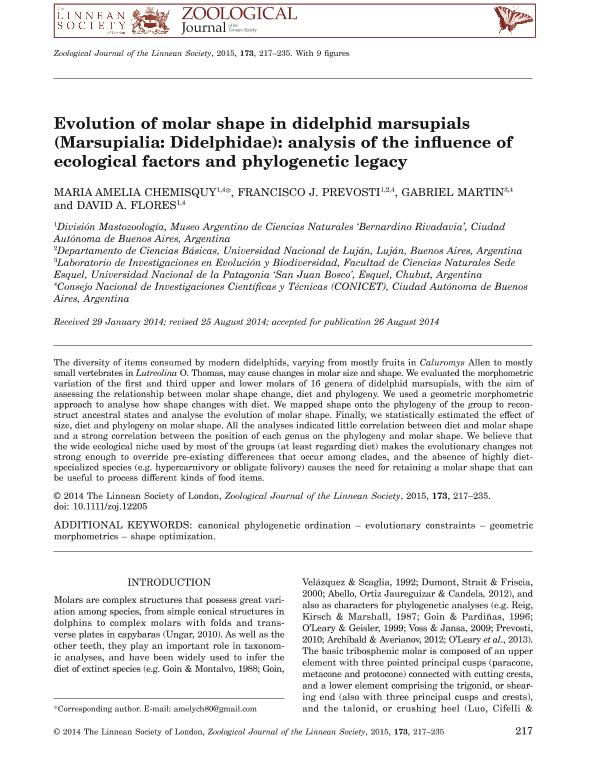Artículo
Evolution of molar shape in didelphid marsupials: analysis of the influence of ecological factors and the phylogenetic legacy
Fecha de publicación:
01/2014
Editorial:
Oxford University Press
Revista:
Zoological Journal Of The Linnean Society
ISSN:
0024-4082
Idioma:
Inglés
Tipo de recurso:
Artículo publicado
Clasificación temática:
Resumen
The diversity of items consumed by modern didelphids, varying from mostly fruits in Caluromys Allen to mostly small vertebrates in Lutreolina O. Thomas, may cause changes in molar size and shape. We evaluated the morphometric variation of the first and third upper and lower molars of 16 genera of didelphid marsupials, with the aim of assessing the relationship between molar shape change, diet and phylogeny. We used a geometric morphometric approach to analyse how shape changes with diet. We mapped shape onto the phylogeny of the group to reconstruct ancestral states and analyse the evolution of molar shape. Finally, we Statistically estimated the effect of size, diet and phylogeny on molar shape. All the analyses indicated little correlation between diet and molar shape and a strong correlation between the position of each genus on the phylogeny and molar shape. We believe that the wide ecological niche used by most of the groups (at least regarding diet) makes the evolutionary changes not strong enough to override pre-existing differences that occur among clades, and the absence of highly diet-specialized species (e.g. hypercarnivory or obligate folivory) causes the need for retaining a molar shape that can be useful to process different kinds of food items.
Archivos asociados
Licencia
Identificadores
Colecciones
Articulos(MACNBR)
Articulos de MUSEO ARG.DE CS.NAT "BERNARDINO RIVADAVIA"
Articulos de MUSEO ARG.DE CS.NAT "BERNARDINO RIVADAVIA"
Citación
Chemisquy, Maria Amelia; Prevosti, Francisco Juan; Martin, Gabriel Mario; Flores, David Alfredo; Evolution of molar shape in didelphid marsupials: analysis of the influence of ecological factors and the phylogenetic legacy; Oxford University Press; Zoological Journal Of The Linnean Society; 173; 1-2014; 217-235
Compartir
Altmétricas




